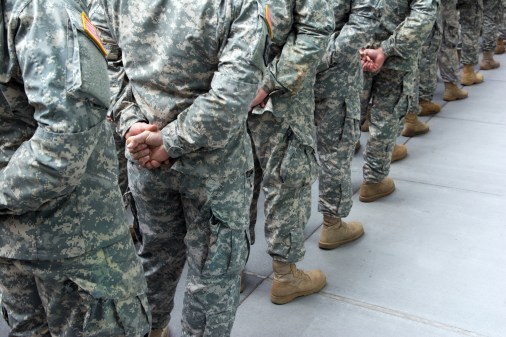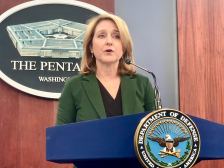CDAO leadership responds to extremely low rating from personnel

Officials steering the Pentagon’s Chief Digital and Artificial Intelligence Office are pursuing a series of urgent moves to improve the spirit of their workplace after an internal review revealed that employees are deeply dissatisfied with how senior leaders are running the nascent organization.
On a scale of –100 to 100, CDAO employees’ overall average rating for the “Leadership” category of a recent Defense Department-wide “Pulse Survey” was –17, presentation slides from a CDAO all-hands meeting on May 10, obtained by DefenseScoop, reveal.
“Our immediate response to the survey was to build an action plan, including holding an All-Hands meeting to specifically address survey results. As soon as we received the information, we started to act,” Craig Martell, the CDAO’s chief, told DefenseScoop in an email on Wednesday.
In late 2021, employees from four legacy Defense Department organizations — the Joint Artificial Intelligence Center (JAIC), Defense Digital Service (DDS), Office of the Chief Data Officer, and the Advana program — were realigned to form the new CDAO. The office reached full operating capability in 2022, the same year Martell departed from his post as Lyft’s head of machine learning and took the helm at the Pentagon’s new AI office.
“We are so proud of what [CDAO staff] have been able to accomplish and the huge impact they have had, in just a year, on DOD adoption of data, analytics, and AI, while also going through a major reorganization,” Martell told DefenseScoop.
This year marked the CDAO’s first time participating in the department’s annual Pulse Survey, which federal agencies use to get a “pulse check” on how their vast organizations are functioning.
“Nearly the entire workforce and some contractors responded to the survey,” Martell confirmed.
Slides of the survey’s results viewed by DefenseScoop show that — beyond the –17 leadership score — CDAO employees reported that they largely did not feel empowered by leaders, and that issues associated with communication and management are impacting office morale.
In response to questions about that specific feedback, Martell said: “Understanding there is always room for improvement, we are continuing to mature the following administrative programs to ensure the free flow of information from the highest levels of the organization to the most junior: improved supervisor training, mentorship meetings, and recurrent ‘all hands’ meetings. As a digital organization, we are also assessing tools to help with information flow and connecting our workforce with each other and others across DOD.”
The office ultimately opted to analyze the data aggregated from the DOD Pulse Survey in the form of a Net Promoter Score (NPS), which is commonly used for employee engagement and customer sentiment scoring in the private sector. That score is calculated by subtracting the percentage of negative responses from the percentage of positive ones.
“CDAO’s overall NPS was 27,” Martell noted — but his team “chose to go one step further and group responses into more specific categories to help us target where we need to improve most as we mature as a new organization.”
“The categories are Leadership, Enablement, Engagement, Development and Culture. While our Leadership score was minus 17, Enablement was 56,” Martell noted.
According to the slides from the May 10 all-hands meeting, the CDAO scored a 27 on Engagement and a 49 on Culture. Comparatively, the DOD-wide averages on this survey were: 55 for Engagement, 25 for Leadership, 54 for Enablement and 61 for Culture.
CDAO’s Leadership rating was the only negative score in any category across the entire Defense Department, on this Pulse Survey.
“The leadership component of the survey consisted of questions related to how well communication flows across the organization and whether leaders act early to address problems. An NPS of –17 on these categories indicates we need to improve communication up and down and across the org, and we need mechanisms to more effectively elevate and resolve barriers that exist to our people doing their best work,” Martell noted.
Part of the office’s new action plan generated in the wake of these results includes assessing how to improve internal processes, tools and forums to address the concerns spotlighted by the survey.
“Other factors considered when evaluating responses: merging four disparate organizations into one, leadership and employee turnover, staffing a new organization to full capability, development of an org structure for the workforce, and developing consistent communications flow from leadership to the workforce,” Martell said.
“We are currently addressing all of these issues,” he added.
The office’s leadership team also conducted an hour-long Q&A activity with their workforce in response to the low leadership score.
“We are currently planning a CDAO Culture Building Offsite for this summer. Additionally, in [fiscal 2023] CDAO Leadership will address the ‘Leadership NPS’ through supervisor and executive training to ensure that managers know how and when to engage with their teams and to address problem-areas, providing bi-weekly updates to the workforce to ensure strong communication flow, and implementing a regular cadence of smaller group and supervisor engagements,” Martell told DefenseScoop.
Moving forward, the office also expects to conduct internal surveys three times a year to “continue having a finger on workforce sentiment and ensuring we are moving the needle in a positive direction,” he noted.
“We recognize we have work to do to improve CDAO. Our expectations are high for where we want CDAO to be — as one of the best places to work in DOD — and we are committed to our team to get this right,” Martell said.






